It’s midsummer 1964 and the unthinkable has just happened.
Radar picket stations frantically clog up the airwaves with congruently dire messages. The USSR has launched a massive nuclear strike on North America and Europe. Scores of intercontinental ballistic missiles, deployed from silos in the Soviet Union and from surfaced submarines in the Atlantic and Pacific, are well on their way to reaching their apogee. In less than an hour, entire metropolises will be wiped out and replaced with charred ruins of twisted metal and melted concrete. Everybody’s worst nightmare has come to life.
As NATO-members including the United Kingdom and the United States respond in kind with devastating fury, the business suit-clad members of the United States Secret Service’s elite presidential protective division have shifted into high gear with a mission of their own. The President is unceremoniously hustled out of the White House and into an austere Lincoln limousine, while National Guard jeeps with mounted machine guns sweep the roads ahead of all traffic. The presidential motorcade zips out while klaxons blare and civilians scurry to bunkers and shelters across the city. Soon, the motorcade arrives at Andrews Air Force Base, the gates having been opened in advance with a cleared path straight to the tarmac. The motorcade stops in front of a parked grey and white Boeing 707, and the President is yanked out and then shoved up the airstairs attached to the side of the airliner amidst the incredibly loud howl of the four turbojet engines underneath the wings of the aircraft.
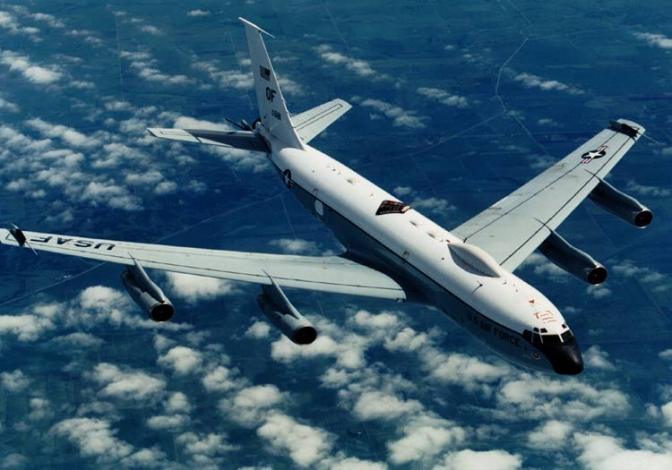
The stairs are pulled away, the doors are shut and the pilots taxi out to the nearest runway, disregarding traditional procedure and ignoring the need to request clearance for departure. After entering a steep climb, the 707 will bank onto a heading which will take it to the American Midwest, where a fully-stocked bunker and command and control center awaits the President’s arrival. Though by now, it is an established custom to hail any USAF aircraft carrying the President as “Air Force One”, this modified 707 carrying the leader of the free world is actually called “Nightwatch”. It is the Air Force’s not-so-secret doomsday jet, an airborne command center from which the President and other high-ranking members of government and the military can control and coordinate rescue, response and retaliation efforts in the event that our nightmares come true, and global nuclear Armageddon comes to fruition.
Looking Glass and the Early Days of Nightwatch
Back when the Cold War still posed the threat of going “hot”, the US government decided that it would be prudent to stand up a fleet of special missions aircraft which would serve as insulated aerial command centers, all operated by the Air Force. The aircraft selected as the base platform of the fleet was the C-135 Stratolifter, the military transport version of the Boeing 707 airliner, the first commercially successful jetliner in history. Eleven C-135s were ordered and re-designated EC-135Cs for the “Looking Glass” fleet, a group of command and control jets which would function as a link to America’s nuclear arsenal if ever ground control centers were destroyed or unable to communicate with silos and warships with nuclear weapons delivery capabilities.
Each Looking Glass jet was rewired and outfitted with the latest and greatest in communications gear, countermeasures and range-extension modifications. Specialized air conditioning and modulation systems were installed to prevent radioactive air from penetrating the pressurized cabin and poisoning everybody inside. Radiation shields that would cover the windshield glass in the cockpit were custom-made and kept within easy reach of the pilots and flight engineer. Looking Glass EC-135s were crewed similarly to land-based command posts, with specialized personnel trained in communicating and controlling American nuclear delivery vehicles and weapons. In fact, Looking Glass was officially designated a weapons system, though it couldn’t itself fire a shot; it could still direct hundreds upon hundreds of launches and attacks from American military elements in the air, on the ground or at sea. From 1961 onward, the Air Force kept a minimum of one EC-135C airborne at any given time somewhere in the world, 365 days a year. Programs similar to Looking Glass were also implemented, including “Nightwatch”, “Silk Purse”, “Scope Light”, and “Blue Eagle”, each providing emergency airborne command centers for important military officers, such as
This practice of having an EC-135 airborne at all times carried on till 1990, having accumulated a whopping 281,000 combined flight hours with not a single accident to report. Arguably the most successful Air Force flight program in history. After 1990, Looking Glass EC-135s were still kept on duty, albeit on constant ground alert. These aircraft, as well as those in sister programs like Blue Eagle and Silk Purse, remained serviceable and ready as command posts, but were all eventually retired and replaced.
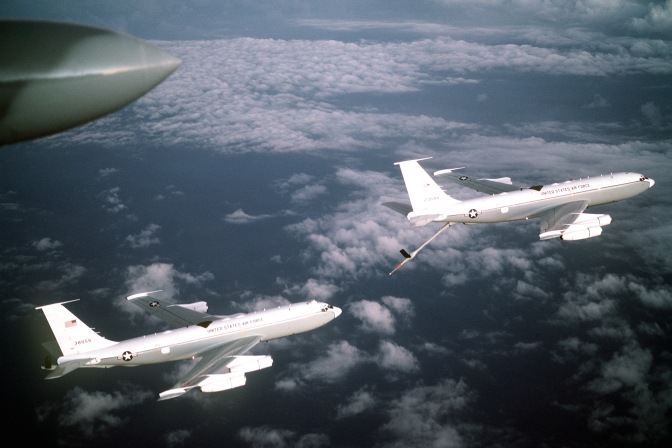
The Nightwatch fleet’s mission was similar to that carried out by the EC-135C jets, but with a slightly different purpose. The fleet’s special callsign was indicative of its unique mission. It would be the platform for a national airborne-based communications network that would be operated should a nuclear war break out; the network was also codenamed “NIGHTWATCH”. Once again, the aircraft of choice was based off the C-135, this time designated the EC-135J. Instead of providing four-star generals and admirals the ability to stay in touch with America’s nuclear arsenal during a hypothetical nuclear war, the EC-135Js would be used exclusively for the President of the United States. If the Cold War went hot, the Commander in Chief would have an unparalleled capability to stay in command of the military, and would be able to manage various assets (including the nuclear force) while on his way to a secure bunker, which contained communications gear of its own. Three EC-135Js were kept at Andrews AFB, Maryland, within close proximity to the White House. All three jets were placed on a permanent rotational standby state, ready to take to the air at a moment’s notice, the flight crews nearby on alert.
A New Era for Nightwatch
Fast forward to the early 1970s.
The 747, more popularly known as the “Jumbo Jet” was soaring into widespread use with Pan American World Airways. The first ever widebody airliner in existence, the 747 was gaining in popularity with other carriers and in no time, Boeing was already developing the upgraded successor to the 747-100, the first of the series. Dubbed the 747-200, it featured better range and improved engines built by Pratt & Whitney. Orders poured in for the aircraft from around the world. Thanks to an airline reneging on its contract, Boeing wound up with a pair of 747-200Bs without a customer to deliver them to. Seeing a potential opportunity to sell those two aircraft to the military, Boeing executives shopped the jumbo jets to the Pentagon as prospective replacements for the EC-135C Looking Glass birds. The 747-200Bs, after being refitted, could do more than the EC-135C, and grant a higher capacity and improved capability to the Strategic Air Command (which managed the EC-135 fleet) when flying a mission analogous to Looking Glass. Boeing decided to focus their offer specifically towards replacing the EC-135J Nightwatch jets still based at Andrews AFB. The Air Force accepted Boeing’s offer and ordered up the completion of the first 747 in the package, with the intention of buying a total of seven, one of which would be used solely for research purposes.
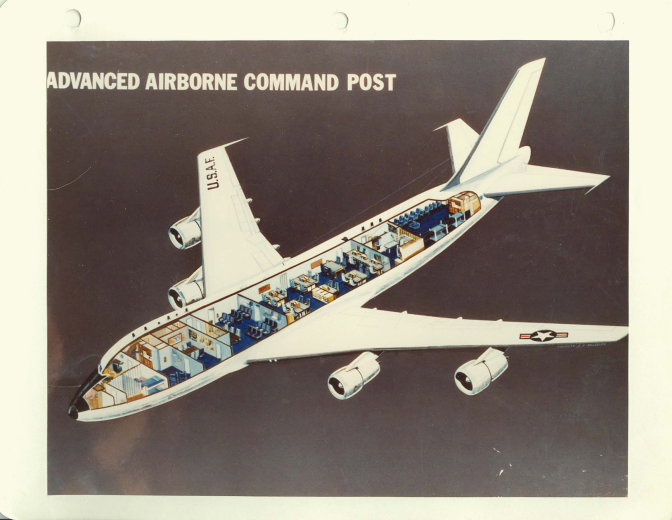
Boeing finished the first Nightwatch replacement jet in 1973, officially given the designation E-4A by the Air Force. E-Systems, now known as Raytheon Intelligence and Information Systems, was given the contract to rewire and refit the E-4A with all of the improved versions of the various computers, communications and control gear which its predecessors used, and the Air Force took delivery of the first E-4A in 1974, also basing it at Andrews. Officially, it was called the National Emergency Airborne Command Post (NEACP), colloquially known as “Kneecap” via the phonetic pronunciation of the acronym.
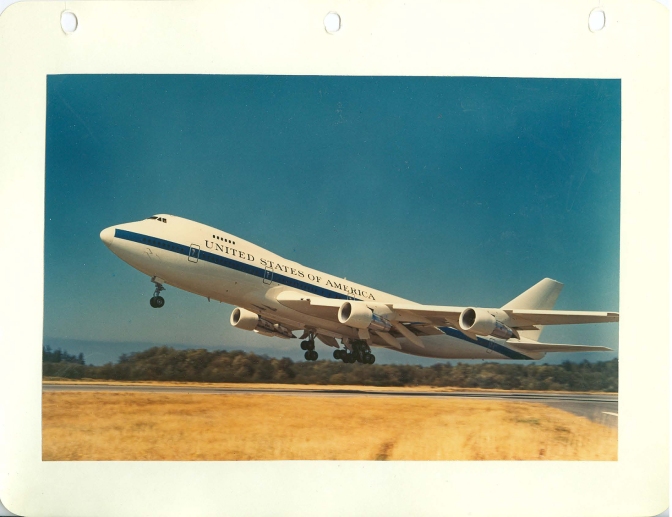
By the end of the 1970s, the Air Force had in its possession three E-4As and one improved E-4B. The first two Nighwatch aircraft were powered by four standard Pratt & Whitney JT9D high-bypass turbofans, while the latter two used General Electric F103 (CF6) turbofans as their powerplants. Eventually, the JT9Ds were replaced with F103s as well, and brought up to the same standard of equipment as the E-4B by the mid-1980s. The
Though the E-4B ostensibly looks like a harmless Boeing 747, such an appearance belies what’s really under its hood, so to speak. Since they were, after all, the Air Force’s doomsday jets, the E-4Bs were tooled accordingly. They were hardened to withstand the effects of a severe electromagnetic pulse (EMP), like one emitted from the detonation of a nuclear warhead, allowing functionality and operability even after a debilitating nuclear attack had commenced. The cabin air conditioning and filtration systems were modified to block and expunge radiation for lengthy periods of time, and special screens with wire mesh similar to the doors you find on your average household microwave oven were created to shield the cockpit windows from absorbing radiation into the aircraft. Though digital flight decks and glass cockpits were quickly gaining in popularity by the late 1980s and early 1990s, the Air Force left the E-4B’s instrument panels with their original analog configuration, as the dials and gauges are less likely to be affected by an EMP than digital displays.
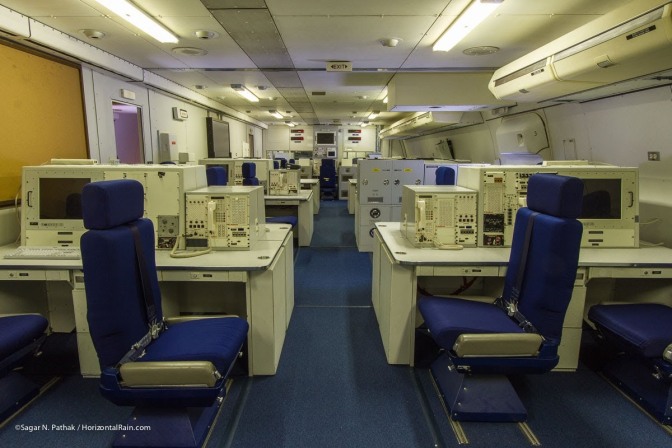
Now, not only is the E-4B capable of resisting the effects of a nuclear detonation, it’s also designed to fly for a hell of a long time. According to Jim Winchester’s Encyclopedia of Modern Aircraft, the E-4B could hypothetically remain flying for up to a week. Thus far, it’s estimated that the Air Force has pushed its E-4Bs to a max of 35 hours in testing and training, though they have the option to greatly exceed those fligh hours if necessary. An in-flight refueling receptacle, located below the cockpit windshield, allows for E-4Bs to be refueled while airborne, using a probe system. To account for the possibility of extended operations, a number of crew qualified to serve on the E-4B are cross-trained so that can not only work their regular assigned stations, but can also often troubleshoot and fix technical issues with the systems they’re assigned to, while in-flight. A typical mission flight roster on an E-4B does include dedicated technicians and crew chiefs, though.
Probably the most important component of the E-4B is its advanced communications suite. The aircraft comes equipped with various antennae, some of which can be trailed behind the plane up to five miles while in-flight. A large blister on top of the fuselage, just behind the cockpit, houses the aircraft’s satellite communications array. The entire suite allows personnel aboard the ability to stay in continuous contact with every American (and allied) military asset available, including nuclear submarines, carrier strike groups, and even land-based missile silos.
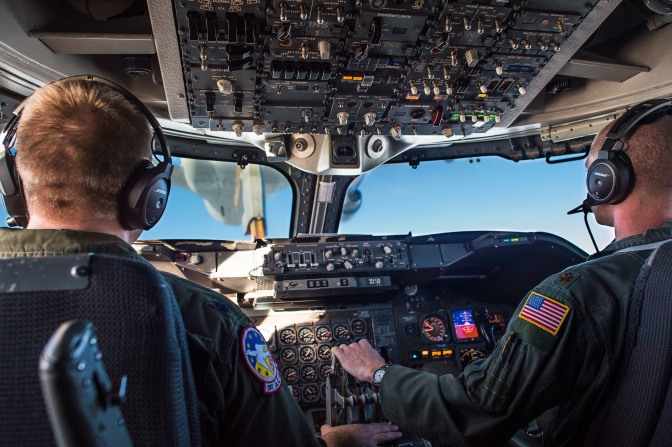
Today, the US Air Force refers to Nightwatch as the National Airborne Operations Center (NAOC, pronounced “Nay-Och”). In the years following the collapse of the Soviet Union and the “end” of Mutually Assured Destruction, Nightwatch has essentially become the sitting US Secretary of Defense’s command post away from the Pentagon. All four E-4Bs still retain their extensive shielding, computers and communications systems, albeit updated to more modern standards. LCD screens have replaced older cathode ray tubes (CRTs) and projectors, and the aircraft has been outfitted with latest and greatest in top-level encrypted gear. Newer send/receive satellite links allow for higher fidelity connections with the American defense network across the world. The E-4B’s cockpit, however, hasn’t changed much. The aircraft’s flight instruments, for the most part, remain a mix of dials and vertical tape gauges. A modern NAOC crew contingent consists of pilots, navigators and flight engineers, flight attendants (yes, the US Air Force has those) communications specialists, and battle staff from the various military branches of the United States.
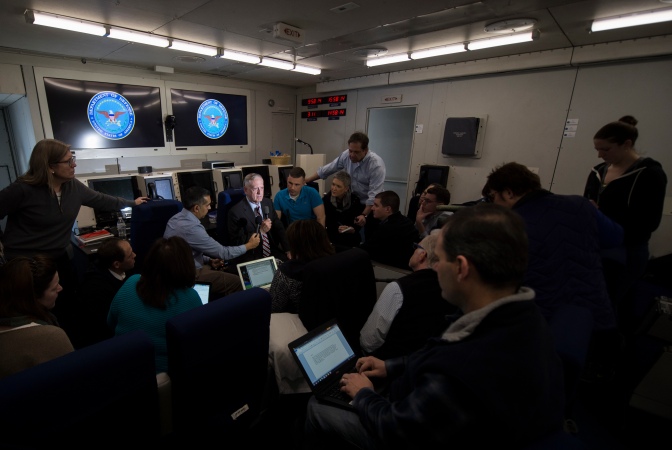
America’s fleet of three NAOCs are available to the Secretary of Defense for official travel outside the country, but are still kept in the alert emergency rotation should the worst conceivable event, man made or otherwise, occur. Should the President of the United States have to travel outside mainland America for whatever reason, an E-4B will usually tag along for the ride, ready to serve as a command center and a backup Air Force One, should something happen to ground the aircraft the President normally flies on. NAOC crew maintain the aircraft with food and provisions, typically large stacks of Meals Ready to Eat (MREs), the same meal packs issued to ground combat troops. When a NAOC is scrambled, its pilots and crew have just minutes to get into the E-4B and buckle into their stations and the aircraft up in the air. The US Air Force ensures that all personnel attached to the NAOC mission are constantly trained and ready for any mission they might be faced with. Security personnel, armed with M9 sidearms and M4 carbines, also travel with the aircraft to safeguard it and its sensitive gear whenever it’s on the ground. All through the aircraft, you’ll find bunk beds and reclining seats, ready for crew rest on especially long missions that could last days. You could probably say that NAOCs are among the most prepared and alert posts in the entire US military!


But all of this does come at a price, and not a very small one at that. Modern military planes are typically very expensive pieces of hardware, and the more specialized they are, the costlier they tend to be. That’s partly why aircraft like the Northrop B-2 Spirit, the United States Air Force’s super-stealthy long-range bomber, rang up massive price tags, numbering in the hundreds of millions per unit produced, not to mention the price of parts, testing, outfitting, etc. The B-2, actually, is one of the costliest aircraft to operate in the US Air Force’s inventory… but not THE costliest. That dubious title goes to Nightwatch. A Boeing 747-400, the most popular iteration of the 747 Jumbo Jet series, in service today with airlines around the world costs around $24,000 to $29,000 USD per hour to operate. An E-4B, on the other hand, costs the USAF a staggering $159,529 USD per hour to fly. Big difference.
Today, Nightwatch’s original mission doesn’t really exist anymore, but all four aircraft are still extremely useful assets to maintain. The last time an E-4B flew during a national crisis situation was during the September 11th attacks of 2001. Thankfully, the aircraft hasn’t had such a mission since. In 2007, then-Secretary of Defense Donald Rumsfeld brought out a plan to retire the E-4B fleet altogether, but this was quickly nullified the following year, when it was determined that there was no suitable replacement for the E-4B. The aircraft so specialized and uniquely equipped for the range of duties it was built for, that no other aircraft in Air Force service could possibly come close to fulfilling the E-4B’s mission and role. By 2039, however, all four E-4Bs will have reached their maximum lifetime operational limits, and will need to be retired. It’s not out of the question for the Air Force to explore a replacement for the E-4B, though it’s not very likely that the follow-on will be another 747 Jumbo Jet, unless Boeing keeps its 747-8 (the latest version of the 747) production line open. Decades upon decades after the first concept of a doomsday plane took to the skies, these powerful aircraft have still yet to fly the mission they were originally designed for… and that’s a good thing. But in the event that the worst does happen, the US Air Force stands prepared with its small but potent fleet of E-4B NAOCs, ready to execute the Nightwatch mission as soon as the Klaxon alarm sounds.
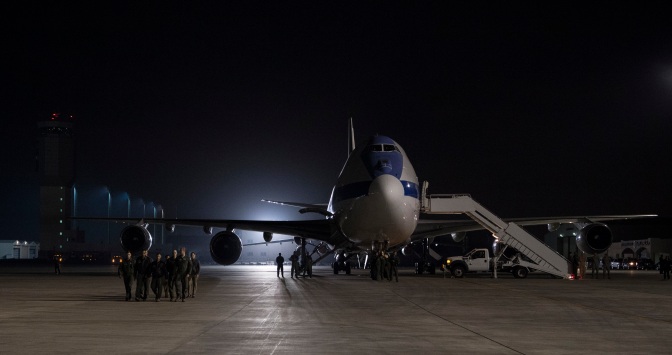

I crewed on both the A and B models at Offutt in the early 80’s. Thanks for a well researched article. We had great planes and better crews!
LikeLike
Can you assist me with my research topic? Thanks.
LikeLike
As best I can. I would be glad to.
LikeLike
Thank you. Can we take this offline?
LikeLike
Yes
My email is rusty.mascari@gmail.com
LikeLike
As best I can. I would be glad to.
LikeLike